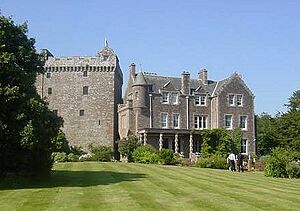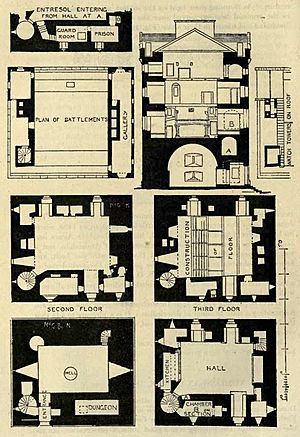Comlongon Castle facts for kids
Comlongon Castle is an old tower house built a long time ago, either in the late 1400s or early 1500s. It's located about 1 kilometer (0.6 miles) west of a village called Clarencefield. It's also about 10 kilometers (6 miles) south-east of Dumfries in south-west Scotland. The original tower has been made bigger by adding a grand mansion, which was finished around 1900.
The castle was first built by the Murray family, who were known as the Murrays of Cockpool. It stayed in their family for many years, until 1984. After being empty for some time, the castle was fixed up. Now, both the castle and the mansion are used as a hotel. However, in April 2019, the hotel business faced some problems. This meant that many weddings and bookings had to be cancelled, and the castle's future became uncertain for a while.
A Look Back: Comlongon Castle's Story
In the early 1300s, a powerful person named Thomas Randolph, 1st Earl of Moray, gave the land where Comlongon Castle now stands to his nephew, William de Moravia. William was an ancestor of the Murray family of Cockpool.
The Murrays built Comlongon Castle to replace their older home, Cockpool Castle. Today, only some old earthworks remain of Cockpool Castle. Experts believe that Cuthbert of Cockpool, who died in 1493, started building Comlongon. However, his son, John Murray, got permission to build around 1500. This makes some people think the castle was built in the early 1500s. We know for sure it was standing by 1508.
The Murray family owned Comlongon Castle for a very long time. Later, some of their family members became important nobles, like Viscounts Stormont and Earls of Mansfield. The castle remained part of the Earl's property until 1984.
An earlier mansion was built next to the castle in the 1700s. This was replaced by the current grand house in 1900. Local architects, John M. Bowie and James Barbour, designed it. From 1939 to 1952, the mansion was even used as a children's home by an organization called Barnardo's. After that, it was sometimes used for different things. Later, the Earl sold it to Tony Ptolomey, who worked hard to turn both the tower house and the mansion into a hotel.
The hotel became a popular place for weddings. However, in April 2019, the business faced difficulties and had to close for a period.
Exploring Comlongon Castle's Design
The castle's tower is made of red sandstone and is described as being "exceptionally complete." This means it's still in great condition. It measures about 15 meters (49 feet) by 13 meters (43 feet) and stands 18 meters (59 feet) tall. It has a special stone base because it was built on marshy, wet ground.
The main entrance to the tower still has its original "yett." This is a strong iron gate with a criss-cross pattern. Inside, the walls are very thick, up to 4.1 meters (13.5 feet) in some places. You'll find a vaulted cellar with a well and two spiral staircases. One main staircase leads all the way up to the roof level. The other staircase goes to the first-floor hall.
The main hall is a very important room. It has a large fireplace with the Royal Arms of Scotland carved above it. Near the fireplace, there's a beautifully decorated "aumbry," which is a special recess in the wall. Its fancy carvings show how wealthy the Murrays were. There was also a smaller fireplace for the kitchen, which would have been separated from the hall by a wooden screen.
The thick walls of the tower hide 12 secret rooms, called "mural chambers." These include sleeping areas and even a guardroom with a small cell. There's also a trapdoor that leads to a dark, unlit dungeon below. Because there are so many rooms inside the walls, the tower's overall strength is reduced. So, it had to be made stronger to support its heavy roof.
A walled courtyard and a ditch, possibly a moat, once surrounded the tower. However, these were removed in the early 1700s when the mansion house was added to the east side of the tower. The Scottish Baronial mansion was designed to look like the older tower. It has many decorative features like crow-stepped gables and corbels. It also includes some interior designs from the 1700s. Both Comlongon Castle and its tower house are very important historic buildings in Scotland.
See also
 In Spanish: Castillo de Comlongon para niños
In Spanish: Castillo de Comlongon para niños



